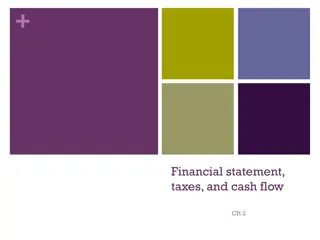Understanding Income Statements in Financial Accounting
An income statement, comprising of a Trading Account and Profit and Loss Account, is vital for assessing a company's financial performance. It helps determine profits, losses, and overall worth. The Trading Account specifically calculates the gross profit or loss from core activities, while the Profit and Loss Account evaluates net profit after deducting expenses. Key elements include sales, opening stock, and expenses, enabling a detailed analysis of a business's financial health.
Download Presentation

Please find below an Image/Link to download the presentation.
The content on the website is provided AS IS for your information and personal use only. It may not be sold, licensed, or shared on other websites without obtaining consent from the author. Download presentation by click this link. If you encounter any issues during the download, it is possible that the publisher has removed the file from their server.
E N D
Presentation Transcript
Chapter 27 Learning intentions In this chapter you will learn to: Explain the term final accounts Outline the reasons why businesses prepare final accounts Outline the purpose of the income statement (trading account) List and explain the key elements of an income statement Prepare an income statement (trading account) in order to calculate gross profit. Textbook page reference: 319
Chapter 27 Introduction to final accounts Every year, an organisation needs to answer two important questions: 1. How much profit (or loss) did it make this year? 2. How much is the organisation worth? To find the answers to these questions, a company will prepare a set of accounts. Textbook page reference: 320
Chapter 27 The Income Statement An income statement is made up of a Trading Account and a Profit and Loss Account. Textbook page reference: 320
Chapter 27 The Income Statement The trading account section calculates the gross profit (or loss) that the business has made from selling its products or services. Textbook page reference: 320
Chapter 27 The Income Statement The profit and loss account calculates the net profit (or loss) after deducting expenses from the gross profit figure. [See chapter 28] Textbook page reference: 320
Chapter 27 The Trading Account The trading account section of an income statement is used by a business to calculate gross profit or gross loss on its core activities. This is the gross profit (or loss) generated by a business as a result of making and selling its products. It does not include expenses, such as electricity or wages. Textbook page reference: 320
Chapter 27 The Income Statement Sales is the value of the goods sold by the business. Textbook page reference: 321
Chapter 27 The Income Statement Opening stock is the cost of goods held in stock at the beginning of the financial year. This may be stock of finished goods and/or raw materials. Textbook page reference: 321
Chapter 27 The Income Statement Purchases is the cost of goods bought during the year. These goods are bought with the specific intention of reselling them. Textbook page reference: 321
Chapter 27 The Income Statement Carriage inwards is the cost of having purchases delivered to the business. Textbook page reference: 321
Chapter 27 The Income Statement Customs duty is a tax paid on purchases from countries outside the EU. This item may also appear as import duty. Textbook page reference: 321
Chapter 27 The Income Statement Closing stock is the value of goods held in stock at the end of the financial year. This may be stock of raw materials and/or finished goods. Textbook page reference: 321
Chapter 27 The Income Statement Cost of sales/cost of goods sold is the cost to the business of selling the goods that were actually sold during the trading period. Textbook page reference: 321
Chapter 27 The Income Statement The most basic Income Statement (trading account) will have just four items and they will appear in the following order: 1. Sales 2. Opening stock 3. Purchases 4. Closing stock Textbook page reference: 321
Chapter 27 Remember Sales Opening stock Purchases Customs Duty Carriage In Closing Stock Some Old People Can Drive Cars In Space! Textbook page reference: 324
Chapter 27 Recap and review Can you? Explain the term final accounts Outline the reasons why businesses prepare final accounts Outline the purpose of the income statement (trading account) List and explain the key elements of an income statement Prepare an income statement (trading account) in order to calculate gross profit.
Chapter 27 Credit slide Shutterstock























